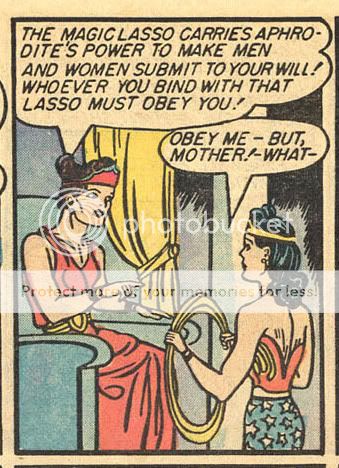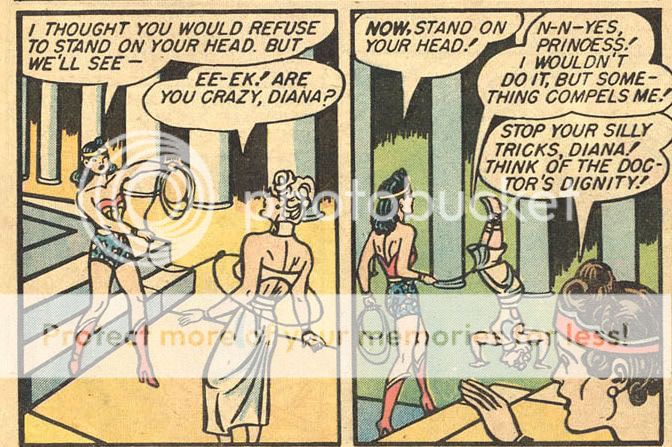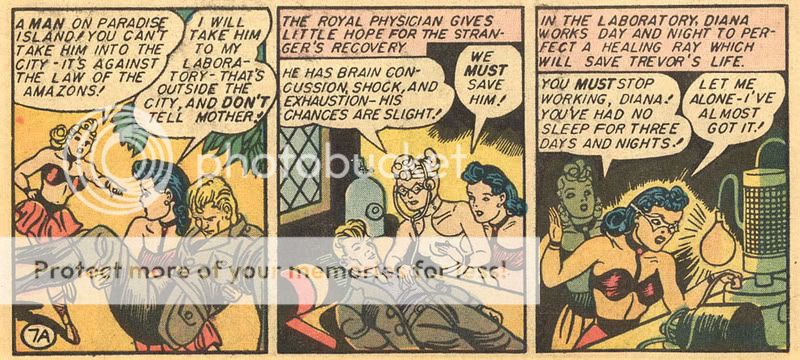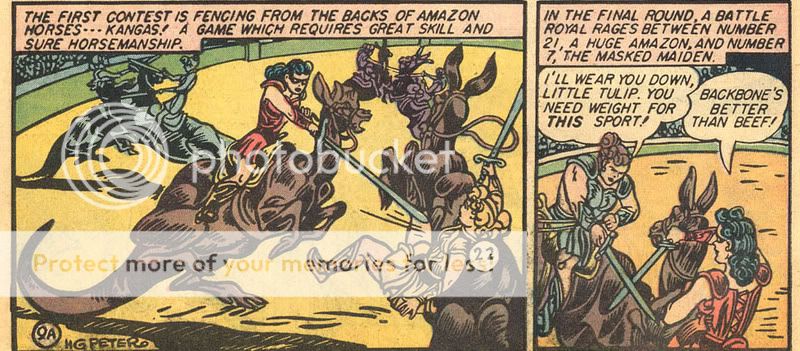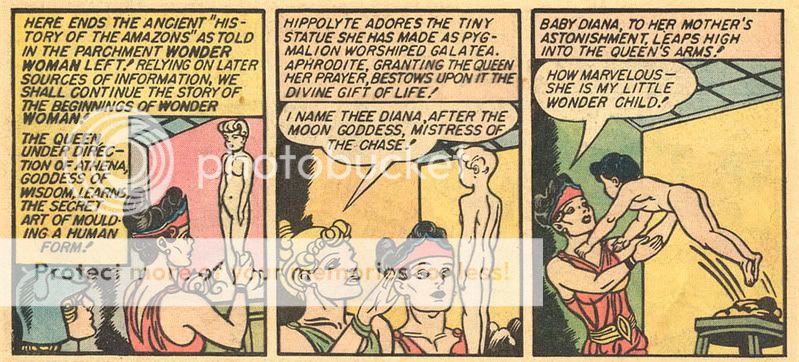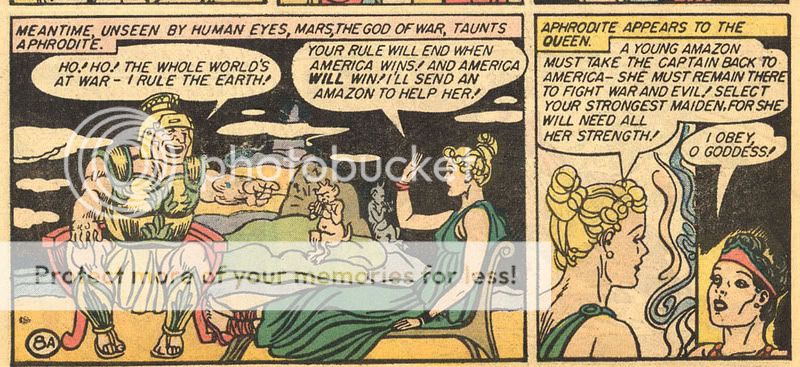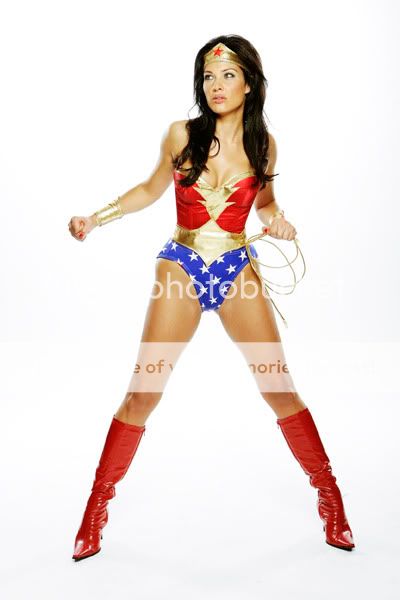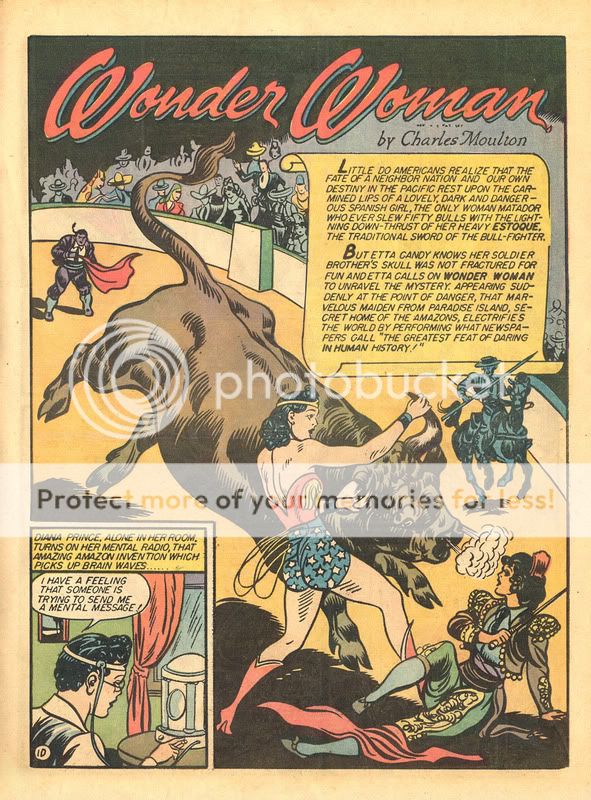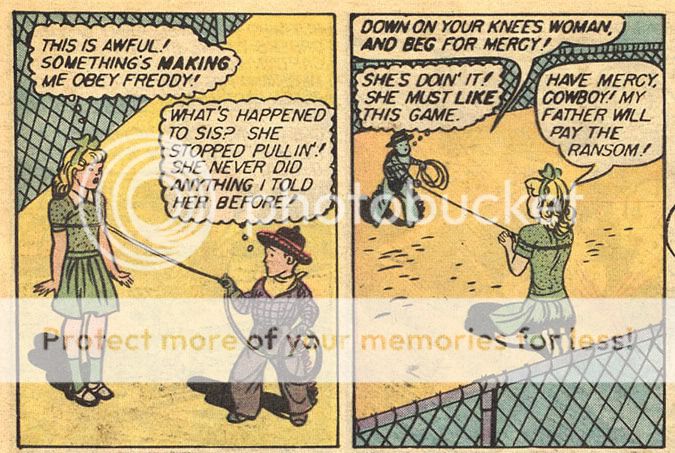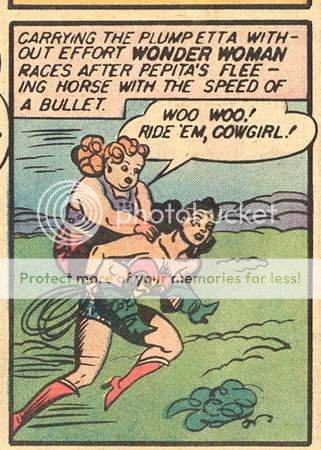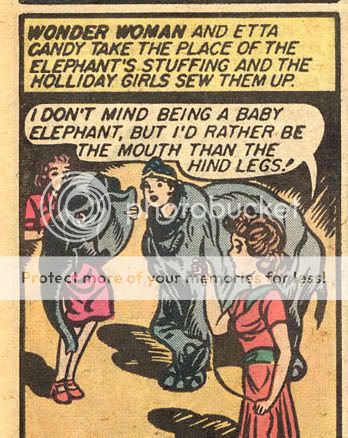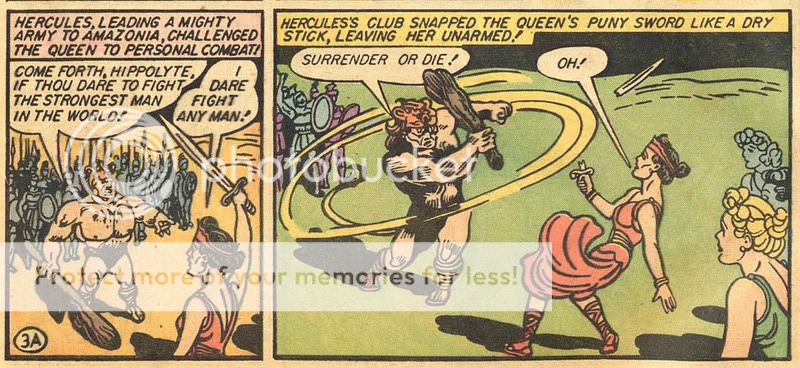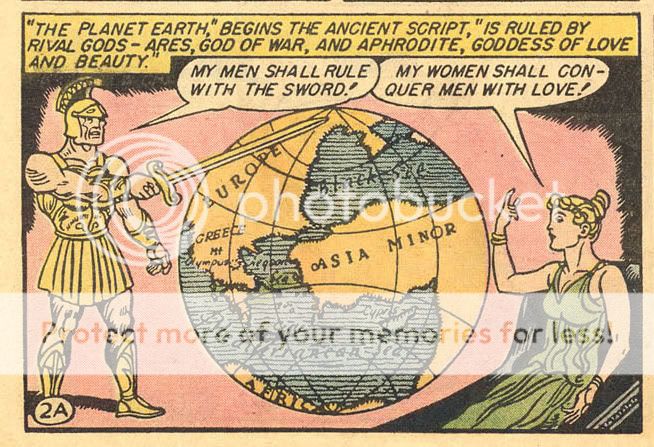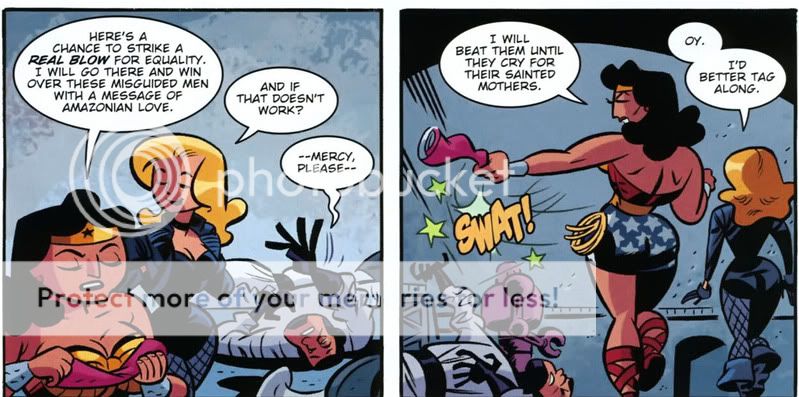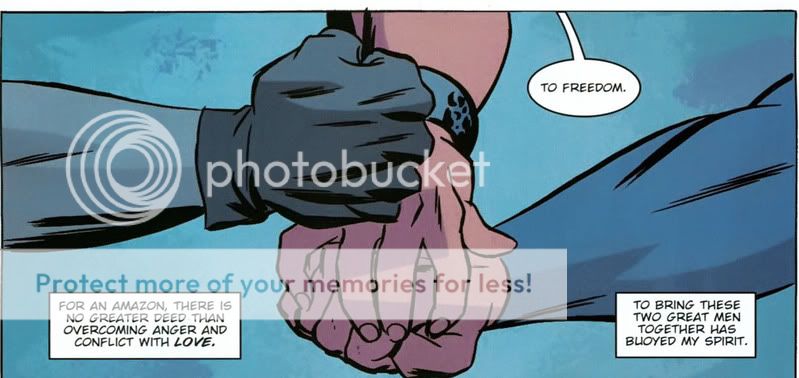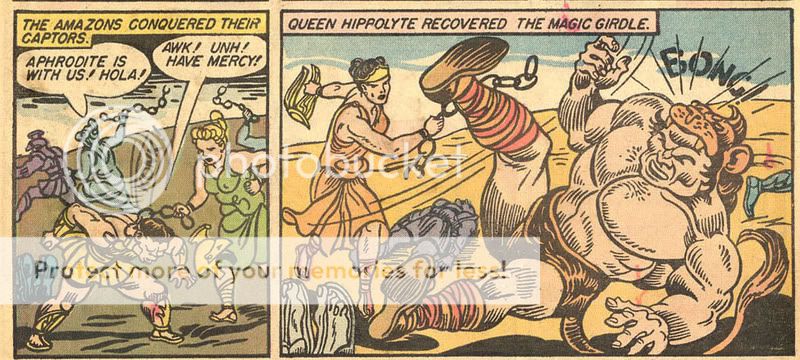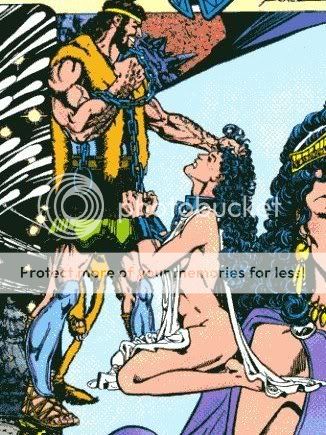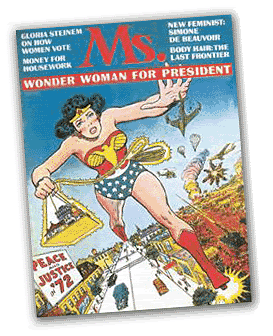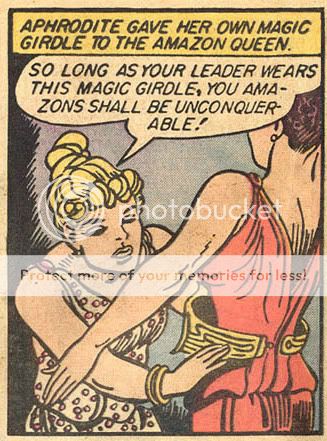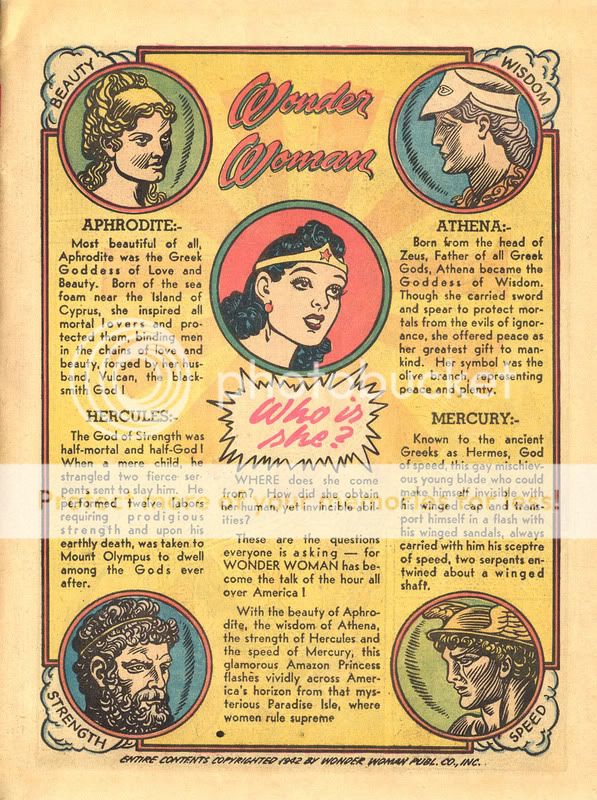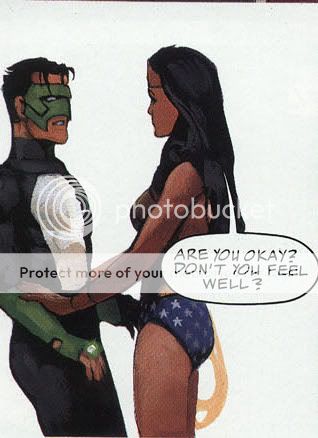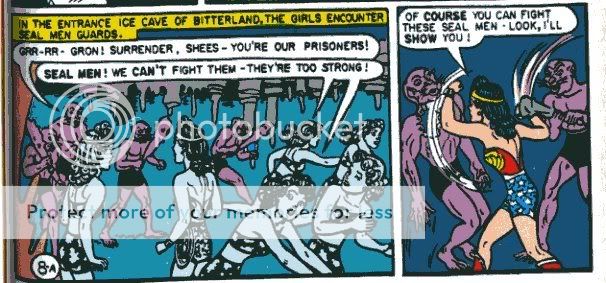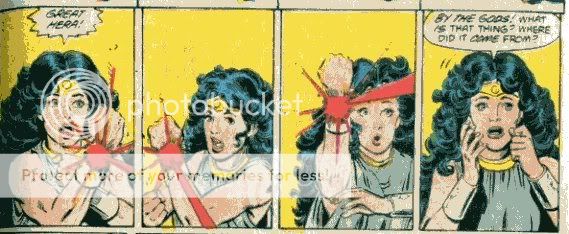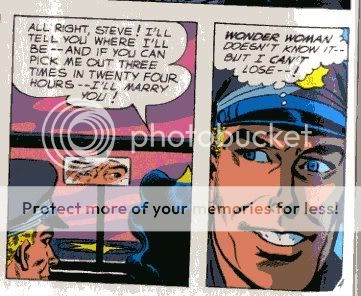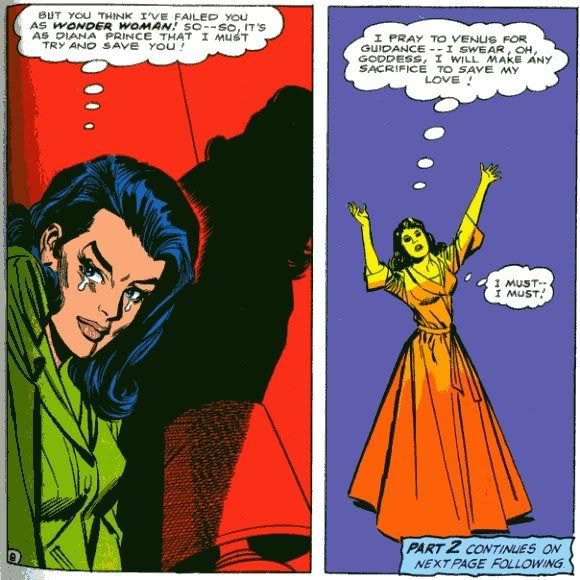Previous posts on WW in this series: One Two Three Four Five, Six, Seven and Eight.
__________
So I’ve been talking here and here about the first issue of Wonder Woman by her creators, Charles Moulton and Harry Peter. One of the (many) panels from that issue which made me laugh out loud was this one:

Hey girls! Disobey your Mom and you too can have new clothes and a ticker-tape parade!
And to show just how unlikely you are to see it in the oughts….I give you Greg Rucka’s Hiketeia. Moulton’s Diana is all about possibility; excitement and fun and adventure; she does what she wants, and is praised and admired for it. Rucka’s WW on the other hand, is all about duty and restriction. She doesn’t even get to defend the weak by choice. The Hiketeia is (in the comic at least) a Greek ritual in which a supplicant asks for protection. Some random girl (Danny) shows up on WW’s doorstep and invokes the ritual; WW accepts the supplication, which means that she is responsible for protecting the girl, no matter what, or the Furies will kill her. It turns out Danny has killed a bunch of bad men who raped and pimped out her sister; Batman is following her, so WW and Batman have to fight, and then there’s a much-foreshadowed tragic finish. Through it all, WW never gets to act or even think for herself; her initial moment of impulsive sisterly bonding and compassion trap her completely — “I have no choice” and “It doesn’t matter” are her mantras.
Danny talks about how much she wants to be like WW, but it’s hard to see why any girl would be especially inspired by this dour vision of toilsome female duty. In taking from Diana choice, he also takes away her heroism; she becomes a boring mother/victim, sacrificing herself not because she’s dashing or brave, but because that’s what moms do. Even her battles with Batman seem rote and, oddly, diminish her. She beats him easily — so easily that it seems less like two fierce competitors battling for glory than like a mother smacking down a wayward child. Batman’s effort to evoke the Hiketeia towards the end (which WW rejects) makes the masochistic mother-fetishization even more explicit. And then, of course, Danny kills herself — because she can’t bear coming between WW and Batman. So much for sisterhood.
Rucka is going for noir here, of course. Linking Greek tragedy with noir isn’t a bad idea; both forms are about the disaster caused by human weaknesses; tragic flaws leading noble, or charming, or compassionate people into death and defilement. There are two problems with this approach, though. First, noir gets across in large part on its stylish visuals, and while there are many adjectives one could use to describe J.G. Jones’ art (lumpy, muddy, cluttered, ugly), stylish isn’t really among them.
Second, noir requires a certain amount of bloody-mindedness. Rucka is willing to do depressing and he’s willing to do melodrama, but his stomach for gore and unpleasantness isn’t up to the story he’s written. Danny, for example, is a frustratingly blah character as well…frustrating because Rucka seems to go out of his way to make her as passive as possible. This is a naive, tiny woman who, supposedly, hunted down, outsmarted, outfought, and murdered a bunch of older, meaner, streetwise thugs. How’d she do it? How did she feel about it at the time? How did they feel about it? What happened? Rucka tells us none of that. The entire sequence is elided, barely shown even in flashback. The defilement of Danny’s sister is shown in at least passing detail, but the humiliation of the victimizers? Nada. Rucka has written a rape-revenge story — that’s the actual interesting part of the narrative, not the nonsense with the furies and Batman and Wonder Woman. But he won’t tell it, perhaps because he’s squeamish, and/or because imagining a woman as active and vicious, rather than as victim, doesn’t engage him.
All of which just makes me appreciate rape-revenge exploitation movies that much more. In They Call Her One Eye, for example, Christina Lindberg doesn’t need her sister or Wonder Woman to come help her our when she’s raped and beaten; she sets out on a rigorous training regime (like Batman) and then she systematically and brutally just murders everyone who fucked with her (literally or figuratively.) I think in the denoument she buries her chief tormenter in filth, ties a rope to his neck, ties a horse to the rope, and then has the horse decapitate the baddy. I guess if Danny did stuff like that, you can see why Batman is upset. Maybe Rucka feels like we wouldn’t sympathize with her if we saw her wreaking havoc? If so, that’s a deep, deep misunderstanding of the way genre fiction and heroism work…. More likely he just wanted to focus on his boring, precious Wonder Woman.
The above is not nearly as gruesome as this movie gets. But it’s pretty gruesome, so be warned.
Which leads us to the third problem. Noir (and Greek tragedy for that matter) needs flawed characters. The flaws not only move the plot and create the tragedy; they also make the characters sympathetic and interesting. In that great Haney Batman/Deadman story I blogged about a while ago, for example, everybody involved in the story is shown to be a fool/cad/bounder; Batman’s a selfish grandstander; Deadman’s a whiny little loser so desperate for love that he commits murder; the main romantic interest is a cold thug. They’re selfish and dumb and they deserve what they get…which makes the story all the more poignant. They’re in control of their destinies — that’s the tragedy.
But this isn’t the case for Rucka’s WW. She’s not selfish or flawed. That means she isn’t a villain, but it also prevents her from being a hero. Even her initial moment of compassion she talks about as if it were out of her hands; something she had to do rather than a choice she made. She’s just this boring maternal paragon, who the Fates have decided to torment, perhaps because they find her insufferably tedious as well.
Rucka has talked in various places about how he wants to respect and honor the Wonder Woman character. And he does respect and honor her. He respects and honors her right onto a pedestal which, as feminists have argued for a while, is not an especially comfortable place to be. Heroes need flaws, or at least moxy. Moulton breathed life into Diana by making her impish and somewhat selfish and excited about her powers. Rucka, on the other hand, seems determined to turn her back into a lifeless figurine.
_____________________
As a somewhat final note: I’ve watched a couple of the old Lynda Carter Wonder Woman TV shows recently. I wouldn’t say they’re good exactly; the writing can be dreadful, and the plotting and pacing are leaden. And, of course, the outfit looks really, really silly on a real person. And Lynda Carter is in no way comfortable playing an action heroine; she always looks distinctly uncomfortable with the physical, ass-kicking portions of the show — like an embarrassed middle-schooler going through the motions in gym class.
Still, I can see why the show was popular. Better than maybe any comics adaptation I’ve seen, the show does capture the excitement of those early stories. Seventies camp isn’t exactly analogous to Moulton’s blend of zany innocence/kinkiness, but the two aren’t completely divorced either. Lynda Carter is a charismatic actor, and the show always takes care to make Wonder Woman the hero; the appeal to girls is pretty clear. Especially, I must say, in the transformation scenes. The spinning-change from Diana Prince to Wonder Woman is more Shazam than Moulton, but it has an exuberance and a visual punch that I think is very true to Moulton’s original conception. The sense that girls can vertiginously grasp hold of power, and that the results will be, not dangerous or horrible, but exciting, fun, and heroic….I don’t see how Moulton could have disapproved of that.
_______________
And I do think that’ll end my Wonder Woman blogging for at least a bit; I’ve got some other projects I need to work on. But thanks to everyone who commented or stopped by. And I may pick it up again — I still want to check out Gail Simone’s work, and would like to read more of the O’Neill/Sekowsky run. So never say never!
______________
Update: This series is now continued with a post about the WW animated movie here

